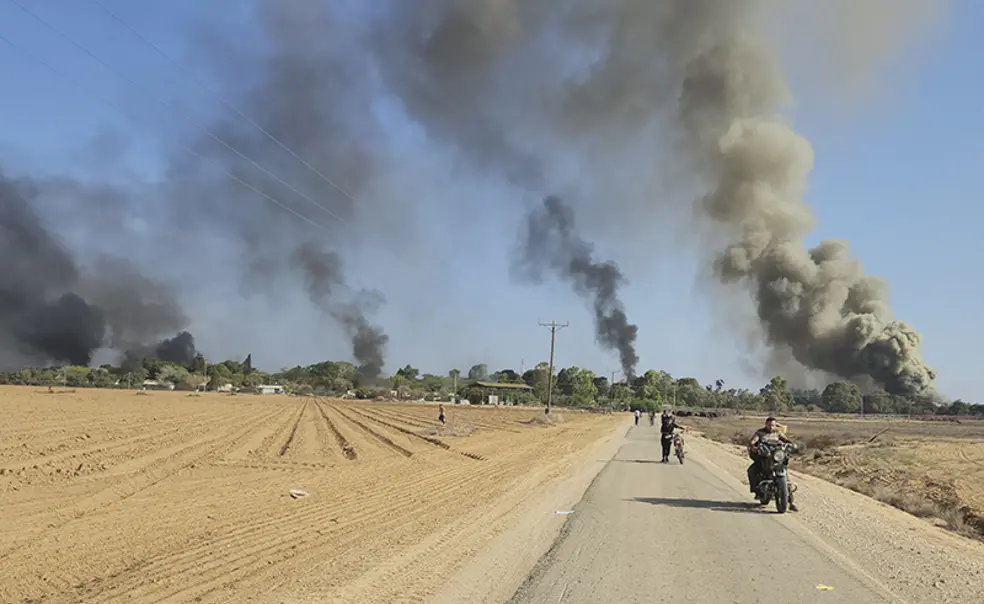At Screening, Princeton Faculty View Horrors of Oct. 7 Attacks
Organizers say the event was meant to combat those who’ve tried to deny or minimize the Hamas massacre
A group of Princeton faculty gathered at Frist Campus Center Dec. 12 to view graphic footage of the Oct. 7 Hamas terrorist attacks that was collected and compiled by Israeli military officials.
Eve Krakowski, an associate professor of Near Eastern studies, and Daniel Kurtzer, a professor of Middle East policy studies at the School of Public and International Affairs (SPIA), organized the screening, which included introductory remarks by Deborah Amos, a Ferris professor in the journalism program and longtime NPR international correspondent.
Krakowski said the event was meant to combat the minimization or outright denial of the massacre and to bear witness to the “horrific and abhorrent” Hamas attacks, which killed more than 1,100 people. About 50 faculty were on hand to hear Amos’ introduction, Krakowski said, and around 30 stayed to watch the screening.
The footage was drawn from several sources, including public cameras in areas where Israeli civilians and foreign nationals were attacked and GoPro cameras worn by Hamas. It has been screened for select audiences in the United States, including members of Congress, public officials and business executives at the Museum of Tolerance in Los Angeles, journalists at the Israeli consulate in New York, and faculty members at Harvard University. According to coverage of earlier screenings, the footage shows Hamas fighters shooting, burning, and mutilating civilians.
Kurtzer, a longtime diplomat in the Middle East and the U.S. ambassador to Israel from 2001 to 2005, said it was “as awful as you can imagine.”
“It’s a very, very hard video to watch,” he said. “My wife was quite concerned that I was going to go see it. And, you know, I’m kind of cynical, hardened. I’ve been around diplomacy for a long time, been through intifadas, was ambassador in Israel for four years of Palestinian intifada and Israeli counterviolence. But this was raw.”
Kurtzer said that Amos’ introduction addressed one potential critique of the screening: that the video was being used to justify Israel’s response, including the dropping of thousands of bombs and an ongoing ground invasion that has resulted in thousands of civilian casualties in Gaza. Israel been criticized around the globe, from Princeton students to U.S. government officials and others in the international community.
“I think what the video did do, at least for me and probably for others, was [give] a sense that there’s no society anywhere that would have reacted differently from the way Israel is reacting — a kind of all-out anger and anguish and response to try to eliminate the problem,” Kurtzer said. “Now, I’ve written a number of articles. I don’t think they can eliminate Hamas. But I don’t challenge their interest in trying to do so, given the barbaric nature of what Hamas did to their citizens.”
Kurtzer also was critical of Hamas for taking civilian hostages during the Oct. 7 attacks. Israel has negotiated the release of 110 hostages, but it believes more than 100 are still being held in Gaza, according to recent reports in The Washington Post. “[W]e’re talking elderly people, elderly men and women, babies,” he said. “This is not, it’s not human. And it goes beyond the conflict. They call themselves a resistance organization. This is not resistance.”
The threat of denialism is significant, Kurtzer added. Prior to the screening, he had spoken with a former Palestine Liberation Organization negotiator who dismissed the footage as propaganda created using artificial intelligence (AI). “I’m not a scientist, and I don’t know about AI, but it was not fake. It was real,” Kurtzer said.
The screening was open to all faculty but not widely advertised. Krakowski said she and Kurtzer reached out directly to peers in departments that study the region, such as SPIA, politics, and Near Eastern studies, and encouraged their contacts to invite others on campus.
Krakowski and Kurtzer arranged to have a psychologist on hand, for participants to speak with if they needed help processing the traumatic scenes they were viewing. Krakowski also said the University provided free speech facilitators, in anticipation of potential protests, but there were no protesters at the event.












2 Responses
George McBride ’65
2 Years AgoWhat Should the University Do?
What should the University do? Expel every student supporting Hamas. Dismiss every employee supporting Hamas. Return to “Princeton in the Nation’s Service.”
DEI and CRT will destroy what is left of classical education and the University. Eliminate it.
Alex Knisely ’75
1 Year AgoDeaths in Gaza
From the article:
Kurtzer also was critical of Hamas for taking civilian hostages during the Oct. 7 attacks. Israel has negotiated the release of 110 hostages, but it believes more than 100 are still being held in Gaza, according to recent reports in The Washington Post. “[W]e’re talking elderly people, elderly men and women, babies,” he said. “This is not, it’s not human. And it goes beyond the conflict. They call themselves a resistance organization. This is not resistance.”
Twenty-two thousand Gazans dead in retribution as I write; among them, to use Mr. Kurtzer’s words, “elderly people, elderly men and women, babies.” Twenty-two thousand, 9,000 of them children.
Israel calls her efforts defense. Her manner of warfare is not defensive but aggressive — and, it seems to me, criminal.